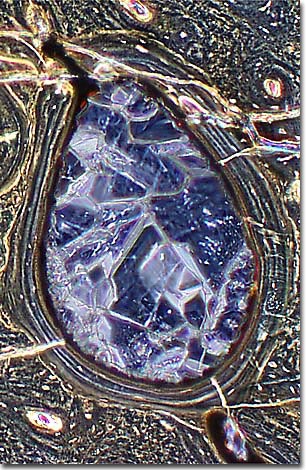Phase Contrast Image Gallery
Allosaurus: The Leaping Reptile
Mineral formation within the Haversian canals is quite evident in this photomicrograph, which was taken during examination of a thin section prepared from allosaurus fossilized bone fragments.

Before Tyrannosaurus rex terrorized the mild-mannered dinosaurs of the world, there was allosaurus, previously known as Antrodemus and also referred to as the "leaping reptile" or "different lizard." This bipedal, meat-eating ancestor of T. rex roamed the Earth 140-150 million years ago during the Jurassic era. (T. rex lived during the Cretaceous.)
A typical allosaurus was 15 feet tall, 35 feet long, and weighed about two tons. Its skull was large in relation to its body -- almost 2.5 feet long -- and its jaws were lined with about 70 curved, razor-sharp, saw-edged teeth. Half of its body length was a well-developed tail that probably functioned as a counterbalance for its large head in addition to its strong hind limbs and a massive pelvis.
While some paleontologists believe allosaurs were too large and clumsy to be good hunters, others think that they were intelligent and hunted their prey in packs. These aggressive dinosaurs appeared to be good enough as hunters, as evidenced by fossilized bones of Apatosaurus (very large dinosaurs) with teeth marks matching those of Allosaurus.
For all its fierceness and effectiveness as a hunter, this was probably not a graceful animal. Broken bones seem to have been a common occurrence in the life of an allosaur. X-rays of one fossilized specimen showed 14 ribs with healed fractures. These fractures were most likely caused by bellyflops that happened while running.
BACK TO THE PHASE CONTRAST GALLERY
